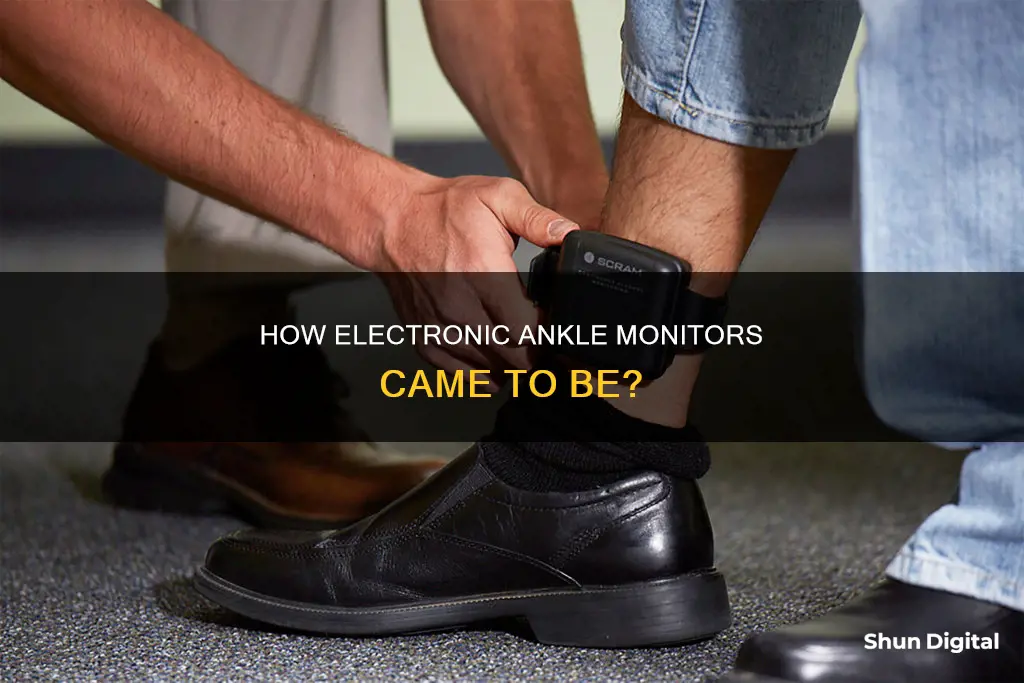
Electronic ankle monitors, also known as ankle bracelets, are a form of surveillance that uses an electronic device affixed to an individual. The use of these monitors has been on the rise in the US, with more than 125,000 people under electronic supervision in 2015, an increase from 53,000 in 2005. The devices are typically used to track the location of individuals who are on bail, probation, or parole, ensuring they comply with the terms of their release. While some argue that these monitors are a more humane alternative to incarceration, allowing individuals to maintain family connections and participate in treatment, others criticise them as a form of digital shackles that deprive people of their liberties and reinforce social stratification.
| Characteristics | Values |
|---|---|
| Inventors | Identical twin brothers Robert and Kirk Gable |
| Year of invention | 1960s |
| Original purpose | To monitor the movements of juvenile offenders and encourage them to show up to places on time |
| Original design | A radio device worn by offenders that communicated their location |
| Original reward system | Offenders would receive simple rewards such as a free haircut, pizza, or concert tickets when they showed up to places on time |
| Current use | Used by courts as a cost-effective way to free up jail space |
| Current technology | GPS and cell tower signals for precise locations, blood-alcohol level detection through sweat |
What You'll Learn

The original purpose of electronic ankle monitors
The electronic ankle monitor was first designed in the 1960s by identical twin brothers Robert and Kirk Gable, who were studying social psychology at Harvard University. The device was initially created for positive reinforcement, with the aim of encouraging juvenile offenders to show up to places on time. The Gables' invention, described in the 1964 journal *Behavioral Science*, envisioned a system that would automatically track young offenders as they moved around a city. The offenders could then be rewarded for showing up at the right place at the right time, with simple rewards such as a free haircut, pizza, or concert tickets. This form of behaviour modification was intended to be a game, with the ultimate goal of rehabilitation.
The Gables' device was the first of its kind and used war surplus missile-tracking equipment to track young adult offenders. The portable electronic tag was called a behaviour transmitter-reinforcer and could transmit data bidirectionally between a base station and a volunteer simulating a young adult offender. The head of this research project was Ralph Kirkland Schwitzgebel (later shortened to Gable) and his twin brother collaborator, Robert Schwitzgebel. The portable transceivers could record the location of volunteers, with the underlying academic project citing the psychological perspective of B.F. Skinner.
The Gables' invention was not without its sceptics. In 1966, the *Harvard Law Review* ridiculed the idea, and a myth emerged that the prototype used brain implants and transmitted verbal instructions to volunteers. Despite this, the concept of electronic tagging continued to evolve, with its first commercial applications appearing in the 1980s.
Today, electronic ankle monitors are used by courts as a cost-effective way to send people home and free up jail space. While the technology has evolved to include GPS and cell tower signals, the original purpose of the Gables' invention was to encourage and reward positive behaviour, rather than solely as a form of punishment or surveillance.
Monitor Red Spots: What's the Issue?
You may want to see also

The inventors' regrets
The inventors of the electronic ankle monitor, twin brothers
Simple Ways to Check if Your Monitor Runs at 144Hz
You may want to see also

The shift from brick-and-mortar institutions to community control
The shift from brick-and-mortar carceral institutions to community control, also known as "e-carceration", has been a significant development in the criminal justice system. This shift involves the use of electronic monitoring or electronic incarceration to track and supervise individuals outside of traditional prisons or detention centres. While this approach has been touted as a more humane and cost-effective alternative, it has also sparked debates and concerns.
The use of electronic monitoring in the criminal justice system can be traced back to the 1960s when social psychology students Robert and Kirk Gable at Harvard University developed the concept of electronic monitoring belts. Their invention, influenced by B.F. Skinner's psychological perspective, aimed to provide positive reinforcement for young offenders by rewarding them for showing up at the right place at the right time. However, the focus shifted from positive reinforcement to punishment and surveillance as the technology evolved.
The first commercial applications of electronic tagging emerged in the 1980s, with the development of portable transceivers that could record the location of volunteers. This technology was soon adopted by law enforcement, particularly for individuals on bail, probation, or parole. The use of electronic monitoring has since expanded significantly, with the number of individuals under electronic supervision in the United States rising from 53,000 in 2005 to more than 125,000 in 2015.
Proponents of community control argue that electronic monitoring offers several benefits. Firstly, it is seen as a more humane alternative to incarceration, allowing individuals to live at home with their families and move freely within their homes. Secondly, it reduces prison overcrowding and saves costs for cash-strapped states. Additionally, proponents claim that electronic monitoring can be used to incapacitate violent criminals, reduce recidivism, and improve the lives of individuals who might otherwise be in prison.
However, critics argue that electronic monitoring fails to address the root causes of crime and can undermine rehabilitation by severing individuals' ties to their communities. The technology has also been criticised for its frequent technical failures and false alarms, which can hinder law enforcement's productivity. Furthermore, the use of electronic monitoring has been associated with racial disparities, as African Americans are imprisoned at a much higher rate than white individuals. There are also concerns about the impact of electronic monitoring on privacy, health, and the financial burden it places on individuals who are often required to pay rental and battery fees for the devices.
Finding Folders: Mediamonkey's Monitoring Magic
You may want to see also

The effectiveness of electronic monitoring
Effectiveness in reducing recidivism and the risk of failure
Several studies have found that electronic monitoring can be effective in reducing recidivism and the risk of failure among offenders. A 2020 study published in the Journal of Criminal Justice found that electronic monitoring produced positive effects for certain offenders, such as sex offenders, and at certain points in the criminal justice process. Additionally, a 2006 study by Kathy Padgett, William Bales, and Thomas Bloomberg evaluated data from 75,661 Florida offenders placed on home detention from 1998 to 2002. The results showed that offenders who wore electronic tags were 91.2% less likely to abscond and 94.7% less likely to commit new offenses compared to unmonitored offenders. Furthermore, a 2013 study in California found that high-risk sex offenders released on parole and fitted with GPS devices had a recidivism rate 38% lower than those without the device.
Failure to meet stated goals
On the other hand, some sources argue that electronic monitoring fails to demonstrably meet its stated goals of ensuring court appearances, protecting public safety, and advancing rehabilitation. The American Civil Liberties Union (ACLU) claims that electronic monitoring expands mass incarceration and leads to further punishment for minor technical violations, charging malfunctions, and false alarms. Additionally, the stigma, social isolation, and stress associated with being monitored can exacerbate mental health issues for wearers. Furthermore, electronic monitoring can be financially burdensome, with fees ranging from $3 to $35 per day, in addition to initial setup charges. This can be especially challenging for individuals from low-income households.
Impact on individuals
The impact of electronic monitoring on individuals is also a factor in evaluating its effectiveness. While electronic monitoring allows individuals to remain in their community, preserve employment, and maintain family support, it can also be restrictive and invasive. Individuals may struggle to adjust their approved movement hours, impacting their ability to work, attend school, or access necessary resources. The visibility of the monitoring devices can also lead to social stigma and judgment.
In conclusion, the effectiveness of electronic monitoring is a complex issue with valid arguments on both sides. While it has been shown to produce positive outcomes in certain cases, there are also concerns about its impact on individuals and its potential to exacerbate existing inequities. Further research and careful consideration of how and when electronic monitoring is used are necessary to fully understand its effectiveness.
Cleaning Your LCD Monitor: Removing Internal Dust
You may want to see also

The ethics of electronic monitoring
Electronic monitoring (EM) is a tool used in community corrections to promote accountability and compliance. While it is highly regarded within the industry, there are several ethical considerations that need to be addressed.
The stigmatization of wearers
The bulky and difficult-to-conceal design of ankle monitors displays the wearer's potential involvement with the justice system, which can lead to stigmatization and invite prejudice. This stigma and the difficulty of hiding the monitor could be seen as part of the punishment, with some drawing comparisons to the historical practice of shaming people, such as the metal masks medieval women convicted of being "nags" were forced to wear. The monitors also make the wearer's criminal record freely available to anyone who notices them, which can compromise privacy and potentially impact their social bonds and employment prospects.
The impact on the wearer's daily life
The monitors can cause embarrassment and be a constant reminder of punishment, with some describing it as a digital shackle. They can also be disruptive in daily life, such as in the case of a student who was kicked out of class due to issues with the monitor. The charging process can be inconvenient, requiring the wearer to remain tethered to a wall for long periods. In addition, the cost of the monitors can be a financial burden, with one wearer reporting a monthly payment of $300.
The potential for false alerts and negative consequences
The technology behind ankle monitors has been criticized as faulty and imprecise, with issues such as lost GPS signals and frequent false alerts. This can lead to an overload of information for both the wearer and the supervising officer, making it difficult to respond effectively to all alerts. In one case, a man in Denver allegedly removed his monitor, committed a crime, and it took days for the police to respond. This raises concerns about the effectiveness of the system in preventing or reducing crime.
The shift from positive reinforcement to punishment
Electronic monitoring was initially invented by Robert and Kirk Gable in the 1960s as a form of positive reinforcement for young offenders, rewarding them for showing up at the right place at the right time. However, its current use has shifted towards punishment and surveillance, with the focus on tracking and restricting the movements of offenders rather than providing incentives for positive behavior. This shift has been viewed as a misuse of the technology, moving away from the original intent of helping individuals change their behavior.
Adjusting Colors on Your ASUS Monitor: A Simple Guide
You may want to see also
Frequently asked questions
The first electronic ankle monitor was invented by twin brothers Robert and Kirk Gable, who were studying psychology at Harvard in the 1960s.
The original purpose of the electronic ankle monitor was to encourage positive behaviour in juvenile offenders by rewarding them for showing up to places on time.
The electronic ankle monitor uses radio frequency technology or GPS to track an individual's movements. The device sends a signal to a receiver, which is able to dial a central computer if the individual moves out of a certain range.
Proponents of electronic ankle monitors argue that they are more cost-effective than traditional incarceration, allow individuals to maintain family and community connections, and can reduce prison overcrowding.







